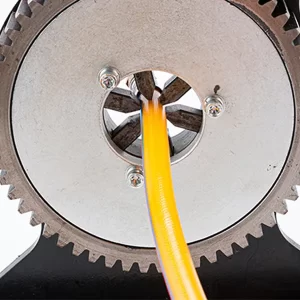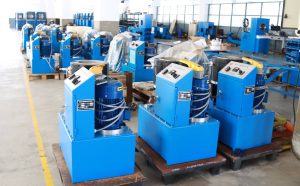Buying a hydraulic hose crimper involves making key decisions that ensure you select the right machine for your business. Whether you’re upgrading your existing equipment or buying a crimper for the first time, there are several factors you need to consider. These factors not only help improve productivity but also ensure safety, cost-effectiveness, and performance. In this article, we will discuss the essential considerations when purchasing a hydraulic hose crimper, and we’ll dive into the most important details to make your decision-making process much easier.
1. What Are the Key Features to Consider in a Hydraulic Hose Crimper?
When looking to buy a hydraulic hose crimper, the first step is to evaluate the key features that will suit your specific needs. But here’s the kicker—choosing the right crimper can make or break your efficiency in the long run. Key features include crimping force, hose compatibility, and ease of use.
Crimping force is vital as it determines how well the machine can handle tough materials. The higher the crimping force, the more robust the crimper is, which is essential for industrial applications. Furthermore, understanding hose compatibility ensures that you buy a crimper that can handle a variety of hoses with different sizes and materials. A crimper with adjustable die sizes will give you more flexibility.
Lastly, ease of use is important. A user-friendly crimper minimizes training time and boosts productivity right from the start. Look for features like intuitive controls, ergonomic design, and automated operations. These elements not only ensure comfort but can significantly improve the speed and efficiency of your operations.
Table: Key Features of Hydraulic Hose Crimpers
| Feature | Importance | Recommended Range |
|---|---|---|
| Crimping Force | Determines strength for industrial tasks | 300 to 1000 tons |
| Hose Compatibility | Handles different hose sizes/materials | 1/4″ to 2″ |
| Ease of Use | Impacts productivity and training time | Automatic vs. Manual |
2. How Do You Choose the Right Size for a Hydraulic Hose Crimper?
What’s the real story behind selecting the correct size for your hydraulic hose crimper? Size isn’t just a physical measurement—it’s about matching the crimper to your operational needs. Choosing the right size depends on the types of hoses you’ll be crimping, and the volume of work you intend to handle.
If you deal with hoses that are predominantly smaller in diameter, a compact, smaller-sized crimper may suffice. But if your work includes handling industrial hoses with larger diameters, you will need a more powerful machine. It’s also important to match the crimper’s size to the scale of your operations. A large factory floor may require a heavy-duty crimper, while smaller, more mobile setups can use lighter models.
Keep in mind that investing in a crimper that is too small can lead to inefficiency, while opting for one that is too large might result in unnecessary costs and space consumption.
Table: Hydraulic Hose Crimper Sizes and Applications
| Size | Ideal Hose Diameter | Recommended Use |
|---|---|---|
| Small (1/4″) | 1/4″ to 3/8″ | Small workshops |
| Medium (1″) | 1/2″ to 1″ | General industry |
| Large (2″) | 1″ to 2″ | Heavy-duty use |
3. What Are the Different Types of Hydraulic Hose Crimpers Available?
So, what type of hydraulic hose crimper suits your needs? There are several types of crimpers, and each one has its advantages based on your specific requirements. Here’s where it gets interesting—understanding the differences between manual, electric, and battery-powered models can guide you toward making the best choice.
Manual crimpers are the simplest and most cost-effective option. They are ideal for smaller shops or for users who don’t need to work with large volumes of hose. However, they require more physical effort and time to operate, which can slow down productivity.
Electric crimpers, on the other hand, offer more automation and speed, making them perfect for high-volume work. They also tend to have a higher crimping force, which is beneficial for tougher hoses. Finally, battery-powered crimpers provide flexibility and portability, making them ideal for field work.
Table: Types of Hydraulic Hose Crimpers
| Type | Advantages | Disadvantages |
|---|---|---|
| Manual Crimpers | Low cost, simple operation | Slower, more labor-intensive |
| Electric Crimpers | Fast, automated, high crimping force | Higher cost, needs electricity |
| Battery-Powered Crimpers | Portable, flexible, easy to use | Limited by battery life and power |
4. What Material Should a Hydraulic Hose Crimper Be Made From?
Here’s something you might not have considered—what’s the best material for your hydraulic hose crimper? Materials play a critical role in the durability, weight, and performance of the crimper. The primary materials used for manufacturing crimpers are steel, aluminum, and stainless steel.
Steel is the most common choice due to its strength and ability to withstand heavy-duty tasks. Aluminum crimpers, while lighter, are typically suited for lighter tasks and smaller projects. Stainless steel crimpers are more resistant to corrosion, making them perfect for applications that involve harsh environments.
The material you choose should reflect the kind of work your crimper will do, and considering the maintenance and care required for each material is essential.
Table: Materials Used in Hydraulic Hose Crimpers
| Material | Benefits | Drawbacks |
|---|---|---|
| Steel | Strong, durable, long-lasting | Heavy, can rust |
| Aluminum | Lightweight, easy to handle | Less durable than steel |
| Stainless Steel | Corrosion-resistant, strong | Expensive, heavier |
5. How Much Power Does a Hydraulic Hose Crimper Need?
What’s the deal with power requirements? The power needed for a hydraulic hose crimper depends largely on its design and intended use. For smaller jobs, manual or battery-powered crimpers may suffice, but for large, industrial-scale tasks, electric crimpers are often necessary.
Hydraulic crimpers use a range of power from 110V to 220V, with higher voltage models offering better performance for larger hoses and higher crimping forces. It’s important to match the crimper’s power with your workload to ensure the machine performs at optimal levels without overloading or underperforming.
Table: Power Requirements for Hydraulic Hose Crimpers
| Type | Voltage Required | Ideal Use |
|---|---|---|
| Manual Crimpers | No power needed | Small tasks |
| Electric Crimpers | 110V – 220V | Industrial-scale |
| Battery-Powered Crimpers | Varies (Rechargeable) | Mobile, field use |
6. What Hydraulic Hose Crimper Brands Are Most Reliable?
Ready for the good part? Brand reputation can be a dealbreaker when purchasing a hydraulic hose crimper. Reliable brands offer durability, performance, and excellent customer service. Some of the top names in the industry include Parker, Gates, and Aeroquip.
These brands have established a strong presence in the market, providing a range of crimping machines suited for various industrial needs. By investing in a known brand, you’re not only purchasing a crimper but also gaining access to a network of support, service, and spare parts.
Table: Trusted Hydraulic Hose Crimper Brands
| Brand | Known For | Recommended Use |
|---|---|---|
| Parker | Durable, high-performance models | Industrial use |
| Gates | Affordable, reliable | General industry |
| Aeroquip | Precision and innovation | Heavy-duty tasks |
7. How Do You Determine the Crimping Range for Your Hose?
Let’s break it down—crimping range matters a lot when you’re choosing a hydraulic hose crimper. The crimping range refers to the size of hoses that the crimper can handle, and it is crucial to match this range with your specific requirements.
Crimpers with adjustable dies offer flexibility, allowing you to work with a wider range of hose sizes. You’ll want to select a crimper that suits the majority of your operations but still provides the ability to work with larger or smaller hoses when needed.
Table: Crimping Range and Hose Size Compatibility
| Crimping Range | Hose Size Compatibility | Recommended Use |
|---|---|---|
| 1/4″ to 1″ | Small to medium hoses | General applications |
| 1″ to 2″ | Medium to large hoses | Heavy-duty tasks |
| Adjustable | Variable sizes | Versatile operations |
FAQ Section
Q1: What is a hydraulic hose crimper?\
A hydraulic hose crimper is a tool used to attach hose fittings to hydraulic hoses by applying pressure to form a secure, leak-proof connection.
Q2: How does a hydraulic hose crimper work?\
A hydraulic hose crimper uses hydraulic pressure to compress the hose around a fitting, ensuring a tight and durable connection that can handle high pressure.
Q3: What are the different types of hydraulic hose crimpers?\
There are manual, electric, and battery-powered hydraulic hose crimpers, each suited for different needs based on the volume of work and portability requirements.
Q4: How do I maintain my hydraulic hose crimper?\
Routine maintenance includes regular cleaning, lubrication, and checking for wear and tear. Calibration is also necessary to maintain the crimper’s precision.
Q5: What is the expected lifespan of a hydraulic hose crimper?\
With proper maintenance, a hydraulic hose crimper can last for many years, typically 5-10 years, depending on usage and the quality of the machine.




